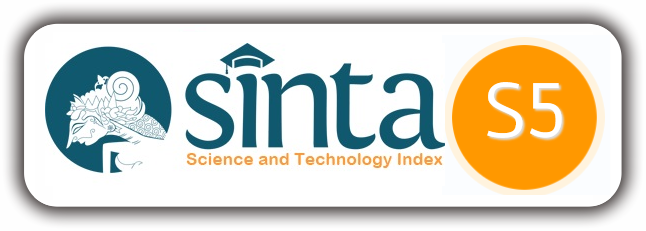EVALUASI PENERAPAN SISTEM INFORMASI MANAJEMEN KEIMIGRASIAN (SIMKIM) KANTOR IMIGRASI KELAS I YOGYAKARTA : PENDEKATAN KUALITATIF
Reyhan Kusuma(1*), Sumiyana Sumiyana(2)
(1) Universitas Gadjah Mada
(2) Departemen Akuntansi, Fakultas Ekonomika dan Bisnis, Universitas Gadjah Mada, Yogyakarta
(*) Corresponding Author
Abstract
Keywords
Full Text:
PDFReferences
A O'Brien, James, (2005), Pengantar Sistem Informasi Perspektif Bisnis dan Manajerial. Jakarta: Salemba EmpatBattacherjee, A. (2001). Understanding information systems continuance: An expectation-confirmation model. MIS Quarterly, 25(3), 351-370.Broadbent, M., Weill, P., and Neo, B. S., 1999. “Strategic Context and Patterns of IT Infrastructure Capability,” Journal of StrategicInformation Systems (8:2), pp. 157-187.Cook, B.G. 1977. Land Resource Information Systems: Use and Display.Dalam: A.W.Moore & S.W. Bie (eds.). Uses of Soil Information Systems. Center for Agric. Publ. And Documentation. Wageningen. h. 37-43.Creswell, John. W. 2014. Penelitian Kualitatif & Desain Riset. Yogyakarta: Pustaka PelajarDavis, F.D. A technology acceptance model for empirically testing new end-user information systems: Theory and results. Ph.D. dissertation, Massachusetts Institute of Technology, 1986.Davis, F. D. (1989). Perceived usefulness, perceived ease of use, and user acceptance of information technology. MIS Quarterly, 13(3), 318-340.Delone, W. H. & Mclean, E. R. 2003. "The Delone and Mclean Model of Information Systems Success: A Ten-Year Update". Journal of Management Information Systems. Vol. 19 Iss. 4, p. 9-30DeLone, W., & McLean, E. (1992). Information system success: The quest for dependent variable. Information System Research, 60-95.Dessler, Gary, 2009, Manajemen SDM : buku 1. Jakarta: IndekFishbein dan Ajzen, 1975. Belief, Attitude, Intentions and Behavior: anintroduction to theory and research. California: Addison-Wesley Publishing Company, Inc.Gary Dessler, 2009, Manajemen Sumber Daya Manusia Edisi Kesepuluh. Jakarta, PT. Indeks.Gibson, James L et al 2006, “Organizations (Behavior, Structure,Processes),” Twelfth Edition, McGrow Hill.Haris Pamugar . 2015 Analisis kesuksesan dan penerimaan terhadap sistem infomasi e-learning di pusat pendidikan dan pelatihan BPK RI. Tesis UGM, YogyakartaHeidarkhani, Arash, Afshin Azad, Qmars Jahanbazi, and Hamed Alipoor. 2013. ‘The Role of Management Information Systems (MIS) in Decision-Making and Problem of its Implementation’. Universal Journal of Mangement and social science 3(3):78-89.Hennink, M., Inge H. &.Ajay B.2011. Qualitative Research Methods. London: SageJ.J. Baroudi, M.H. Olson, B. Ives, "An empirical study of the impact of user involvement on system usage and information satisfaction," Communications of the ACM, vol. 29, no. 3, pp. 232-240, 1986.Jihad, Akbar. “Kronologi OTT Satgas Saber Pungli di Kantor Imigrasi” http://jogja.tribunnews.com/2016/11/07/kronologi-ott-satgas-saber-pungli-di-kantor-imigrasi diakses pada 7 Februari 2017 Pukul 20:30 WIBJogiyanto. 2005. Sistem Teknologi Informasi: Pendekatan Terintegrasi Konsep Dasar, Teknologi, Aplikasi, Pengembangan Dan Pengelolaa. Yogyakarta: ANDIJogiyanto, 2007. Sistem Informasi Keperilakuan. Edisi Revisi. Yogyakarta: Andi OffsetLarsen, R.J., Buss, David M. (2002). “Personality Psychology: Domain of Knowledge About Human Nature”. New York: McGraw Hill.L Kristina H Naibaho (2015). Evaluasi Pemanfaatan Teknologi Informasi dan Komunikasi (TIK) dalam Tata Ruang di Kota Surabaya. Tesis. UGM, Yogyakarta.McKeen, James; Tor Guimaraes dan James C Whetherbe. 1992. The Relationship Between Participation and User Satisfaction of Four Contigency Factors. MIS Quarterly. ABI/INFORM Global.M. L. Markus and M. Keil, “If We Build It They Will Come: Designing Information Systems That People Want To Use,” Sloan Management Review, vol. 35, no. 4, pp. 11–25, 1994.Ndraha, Taliziduhu. 2003. Kybernology Jilid 1 & 2. Jakarta: PT Asdi Mahasatya.Olorunniwo, F., Hsu, M.K., and Udo, G.P. 2006. Service Quality, Customer Satisfaction, and BehavioralIntentionsIn The Service Factory. The Journal of Service Marketing,vol. 20, No.1. pp.59-72.Petter, Stacie, William Delone, andEphraim Mclean. 2008. ‘Measuring Information Systems Success : Models , Dimensions , Measures , and Interrelationships’. European Journal of Information Systems 17:236–63.Radityo, Dody dan Zulaikha. 2007. Pengujian Model DeLone and McLean dalam Pengembangan Sistem Informasi Manajemen. Vol SNA X. Makasar: Simposium Nasional Akuntansi.Rai, A., Sandra S. Lang dan Robert B. Welker (2002) Assessing the validity of IS success models: An empirical test and theoretical analysis. Information Systems Research, 13, 1, 50–69.R, Weber. 1998. Information System Control and Audit. Pretice Hall.Reddy, Satyanarayana et al. 2009. ‘Management Information System To Help Managers For Providing Decision Making In An Organization’. International Journal of Reviews in Computing.Seddon.P.B. 1997. A Respecification and Extension of The DeLone and McLean’s Model of IS Success , Information System Research, 8: 240-250. 33Sekaran, Uma dan Bougie, Roger. 2013. Research Methods for Business. United Kingdom: Jhon Wiley & Sons Ltd.Sutabri, T. (2005). Sistem informasi manajemen. Yogyakarta: Penerbit Andi.Sutherland, J& Schwaber, K, (2014) The Scrum Guide, Scrum.Org and ScrumInc.Yin, Robert. K. 2014. Case Study Research. Fifth Edit. USA: Sage PublicationYulian Ugi Lusianto. 2015. Evaluasi Pemanfaatan Sistem Informasi Manajemen Daerah (SIMDA) Keuangan Terhadap Penyerapan Anggaran (Studi: Pemerintah Kabupaten Lombok Timur). Tesis. UGM, Yogyakarta.Wilkinson, Joseph W. dan Michael J. Cerullo. (1997). Accounting Information System. 3th Edition. (Diterjemahkan oleh Agus Maulana). Binarupa Aksara. Jakarta
Article Metrics
Refbacks
- There are currently no refbacks.
This work is licensed under a Creative Commons Attribution 4.0 International License.
______________________________________________________________________________________________________
2302 - 1500


_logo2.png)





